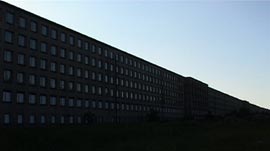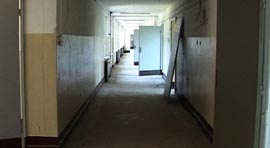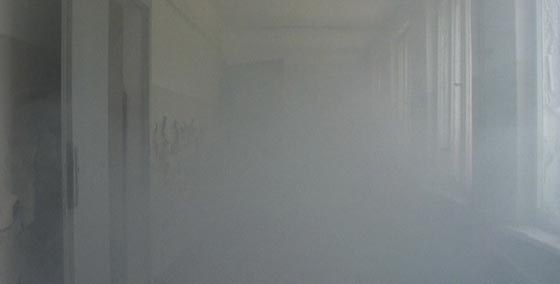
Nuno Cera from October 22nd Private view: Opening hours: Wed - Sat, 14 - 7 p.m. downloadable press-release and images
|
 |
|
|---|---|
Prora:
It was intended to be the masterpiece of Third Reich tourism: Bad Prora,
a giant holiday camp to accommodate 20,000 people, designed by the Nazi
leisure organisation, Strength through Joy (Kraft durch Freude or KdF).
Adolf Hitler himself was behind the plan. He envisaged a colossal seaside
retreat for the German workers, but in 1939, the outbreak of the Second
World War brought construction to a standstill. Today, much of this monstrous
complex lies in ruins in the dunes of Prora. It is one of the most imposing
architectural relics of the Nazi period, alongside the Nuremburg Party
Congress Grounds and Castle Vogelsang.
 |
|
|---|---|
In his artwork, Nuno Cera engages with processes of socio-political
transformation, social hardship and cultural refractions. In his film, “Prora”,
he paints a portrait of a chillingly unearthly structure, using a succession
of travelling shots. He succeeds in revealing the most intriguing spatial
and architectural elements of this legacy of the Nazi era, while still
managing to retain a sense of great detachment. There is no admiration
in Cera’s fascination; he is neither a Romantic nor a Sentimentalist.
For the first time, Cera’s work contains narrative moments, which
convey the feeling of being seized by a fascination for the structure’s
otherworldly character. To balance the overriding documentary nature
of the piece, he introduces music and gradually thickening clouds of
smoke, which drift through the space in the final scene. To be moved
is also to be troubled, and this feeling of unease should not be left
unarticulated. The fog which swirls through the dark gloom of the long
corridors and rooms carries on it Paul Celan’s words of loss and
mourning in his Death Fugue.
Nuno Cera’s films deal with the theme of memory and the sustainability
of the experienced and the perceived. With an oneiric quality, his films
show the viewer how images continually re-play in the visual memory,
how their perceived documentary style combines with a viewpoint that
is subjective and open to interpretation. Prora is a film about a historical
place, a thoroughly uncanny, terrifyingly huge, unending arc, stretching
along the coastline, still standing today, as planned, as a solitary
concrete monolith.
The film expresses the artist’s subjective viewpoint. The protagonist is the space as Cera finds it: damaged, decaying or gutted. This space becomes imprinted on the viewer’s mind and leaves its mark on the memory of the artist.
Wolf-Guenter Thiel
